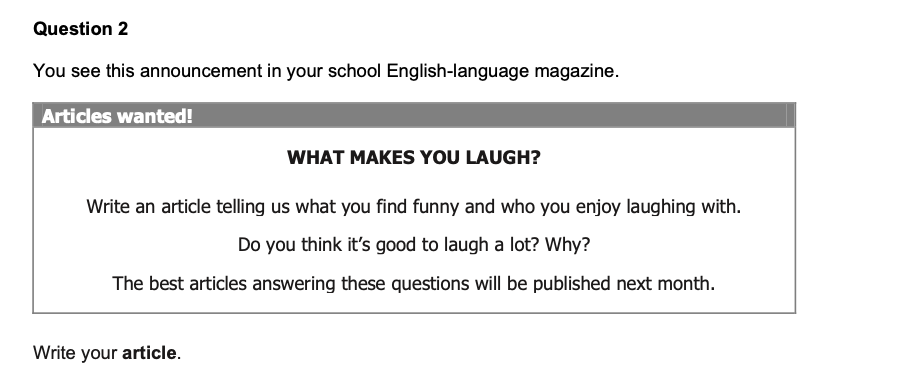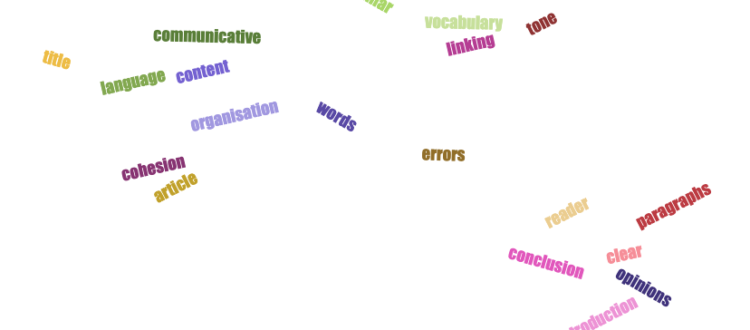How to write an article for B1 Preliminary
In this post, I’m going to share some tips on how to write an article for B1 Preliminary.
You may find my checklists for B1 Preliminary Writing useful too.
Let’s look at the B1 Preliminary for Schools sample writing task, from the Handbook, available from the Teaching resources on the Cambridge English Language Assessment website.
The instructions/rubric
At the top of the screen/question paper page, there are the instructions.

Tip: The number of words is not included in the instructions for each question, so make sure that students remember that they need to write about 100 words!
The article question

Let’s analyse this question. (The advice applies to any article question). I’m going to group my tips and comments into the four areas of assessment.
Content
The context
Students are writing an article for a website or magazine. In this example, they are writing about what makes them laugh, things that they find funny.
The target reader(s)
The people who will read the article will be visitors to the website or readers of the magazine. They will probably be both teachers and students of English. So the article does not need to be formal in style.
Communicative Achievement
Tips
Titles
A title is usually used with an article. The exam question gives us a title that students can transform and use (What makes me laugh) if they can’t think of another one. *But notice that they should change the pronoun in the title you > me.
Tone
The readers will be English language students, like the writer, so the tone should be quite informal.
Content
The magazine wants articles about what makes the writer laugh, so it should include personal opinions and experiences.
Organisation
Tips
Paragraphs
Paragraphs should be used in articles, just as with the email and the story tasks in the B1 Writing Paper.
I recommend 4 paragraphs for B1 and 100 words.
Any piece of writing needs an introduction, the middle content and a conclusion. Articles also need these three things.
In the introduction, students can refer to the question they are answering. In this example, I would start with two questions (again, taken from the exam question and a change in the pronouns): What do I find funny and what makes me laugh? Then, I would give a reaction to these questions, without going into detail.
In the middle two paragraphs, I would give two separate examples of things that make me laugh and a little bit of detail (reasons and/or examples). In the sample answer below, I talk about jokes and memes, etc.
Sentences
Below, you can see that we have a variety of shorter and longer sentences. This is a good approach to take.
Linking words and Cohesive devices
Sequencing. Clear indication of the time and order of events is important in writing. In the sample below, the words ‘Nowadays’, ‘after‘ do this.
Cohesion Relative clauses and pronouns help to make writing more logical, more cohesive. In the sample below, there are several examples: who laughs a lot most days, something that we often do people who share my sense of humour.
Reason
In this example, we have therefore
Contrast
In the example below, we have although
Language
Tips
Vocabulary
Range As far as possible, students should try and use a variety of words in their articles. At B1 level, this will probably be quite limited but they should still try.
In the sample answer below, we can see words related to the topic: funny, laugh, laughing, telling jokes, memes, messages, sense of humour, comedy, comedians
Less common lexis
There are also some words that would be considered more complex, like: spontaneous, receive, forward, share my sense of humour, medicine.
Grammatical forms
Range
Perhaps I could have expanded the range of tenses in the sample article by including an anecdote about a programme, etc. The article contains the present simple.
However, there are some examples of other structures: a conditional: If I can,; -ing form as subject: Laughing is something spontaneous Laughing is good medicine..
Simple
At B1 level, many of the sentences and structures will be simple. It is important that these should be as accurate as possible.
Complex
The relative clauses in the sample answer make it more complex.
The -ing forms as subjects are also more complex structures.
And modal verbs are often mentioned in feedback from Cambridge on sample answers.
Errors
If students make errors because they are trying to use more complex language, then that will be perceived much more leniently by the examiners than mistakes with very simple structures.
There are no errors in the sample answer below. Obviously, students should check their writing both in the exam and when they are writing practice articles.
My Sample Answer
What makes me laugh
What do I find funny and what makes me laugh? For someone like me, who laughs a lot most days, these questions really made me think!
Laughing is something spontaneous, something that we might often do without even thinking why we are laughing! Some people are brilliant at telling jokes. I’m not, although I love hearing them!
Nowadays, we receive memes, videos and messages in our chat groups or on social media. I forward the funny ones to my friends and family after laughing at them myself! I choose people who share my sense of humour. If I can, I also watch comedy programmes and comedians with these people.
Laughing is good medicine. It helps us deal with stress and relax, therefore it should definitely be part of our daily lives.
Further recommended resources
The B1 Writing Checklist from Cambridge is a brilliant resource.
I would also like to recommend JoannaESL’s post about writing articles for B1 Preliminary. It is a full-blown lesson plan, also working on Part 3 of the Speaking Test!

